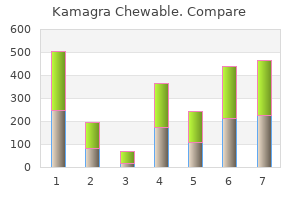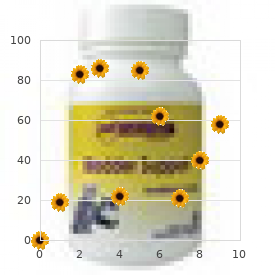"Purchase kamagra chewable from india, erectile dysfunction treatment guidelines".
By: C. Gunnar, MD
Vice Chair, UT Health San Antonio Joe R. and Teresa Lozano Long School of Medicine
Cheap 100 mg kamagra chewable free shipping
Dennis Kerr, being an Australian procedure-specific pain treatment is found on The recommended multimodal opioid ing the wound like a snake-bite (ropivacaine 0. Injection through a catheter been specifically evaluated, a metaanalyses found no convincing has been found to reduce pain26, but in all the studies by Andersen effect of cryotherapy including no reduction of pain or swelling23. However, one has to be careful nique against other modalities: 2 against continuous femoral regarding interpretation of what is causing these improvements nerve block35, 36 and 3 against epidural37-39. Patients were randomized to receive a a multimodal oral analgesic regimen consisting of paracetamol, compression or a non-compression bandage with the assessment celecoxib and gabapentin, and is therefore not recommended. These inhibitors of the inflammatory response multimodal opioid-sparing pain treatment regimen (Table 2). Further dose-response studies as well as safety stud and/or d) less effect of cooling due to more tissue interposed. Even though the transition from acute pain to chronic pain has been predicted by are found to be low-risk procedures by others66. The theory of increased in favor of more differentiated prophylaxis based on risk strati pain responsiveness and central sensitization following major fication. Two interesting studies to be included in this debate In conclusion, a multimodal opioid-sparing analgesia regimen are the studies by Kim et al. Although no randomized controlled studies Fast-track surgery aims at shortening convalescence by opti comparing timing (and amount) of mobilization with bed rest mizing the clinical features as to facilitate the complication-free exist, suggestions of the beneficent effect of early mobilization recovery of the patients, i. During the last 2 years (854 patients), when patients large prospective cohort studies are warranted. Different guidelines have been devel 77-85 and question the need of extended thromboprophylaxis, when oped but are based on older studies with treatment algorithms patients are mobilized early. Also, adding power to the findings of (V) is the inclusion of unselected, consecutive patients as opposed to the majority of the studies 2.
Purchase kamagra chewable with visa
Clinicians should clinicians should optimize other therapies and work ask patients about their preferences for continuing opioids, with patients to taper opioids to lower dosages or to given their effects on pain and function relative to any adverse taper and discontinue opioids (recommendation effects experienced. In practice contexts increase, reassessment of pain and function within 1 month where virtual visits are part of standard care (e. Clinicians should re-evaluate patients particularly when methadone or transdermal fentanyl are who are exposed to greater risk of opioid use disorder or prescribed; that follow-up within 3 days is appropriate when overdose (e. If clinically meaningful improvements harms of opioids within 1 to 4 weeks of starting long-term in pain and function are not sustained, if patients are taking opioid therapy or of dose escalation. Shorter follow-up request dosage reduction or discontinuation, or if patients intervals (within 3 days) should be strongly considered when experience overdose or other serious adverse events (e. At follow up, event leading to hospitalization or disability) or warning signs clinicians should assess benefits in function, pain control, of serious adverse events, clinicians should work with patients and quality of life using tools such as the three-item Pain to reduce opioid dosage or to discontinue opioids when average, interference with Enjoyment of life, and interference possible. Experts noted that tapers slower than such as history of overdose, history of substance use 10% per week (e. Opioid withdrawal during pregnancy has been the clinical evidence review found insufficient evidence to associated with spontaneous abortion and premature labor. However, enough to minimize symptoms and signs of opioid withdrawal based on the contextual evidence review and expert opinion, (e. Clinicians original dose per week is a reasonable starting point; experts should assess these risk factors periodically, with frequency agreed that tapering plans may be individualized based on varying by risk factor and patient characteristics. Experts noted that at times, tapers factors that vary more frequently over time, such as alcohol might have to be paused and restarted again when the patient use, require more frequent follow up. In addition, clinicians is ready and might have to be slowed once patients reach low should consider offering naloxone, re-evaluating patients more dosages. Tapers may be considered successful as long as the frequently (see Recommendation 7), and referring to pain patient is making progress. Once the smallest available dose is and/or behavioral health specialists when factors that increase reached, the interval between doses can be extended. Opioids risk for harm, such as history of overdose, history of substance may be stopped when taken less frequently than once a day. Ultrarapid detoxification Sleep Apnea under anesthesia is associated with substantial risks, including death, and should not be used (200). Clinicians should access Risk factors for sleep-disordered breathing include congestive appropriate expertise if considering tapering opioids during heart failure, and obesity.
Cheap 100 mg kamagra chewable free shipping. Girlfriend vs Wife | S01E01 - Khichdi प्यार की | Pyaar Ke Side Effects | Fuddu Kalakar.

Purchase kamagra chewable from india
This material is not to be reproduced, stored or transmitted for commercial purposes without written permission from the Government of Alberta, Human Services. The manual also presents basic information on asbestos and asbestos products, health hazards, requirements for worker protection, safe work procedures, inspection criteria, applicable legislation and competency profiles for those persons involved in abatement activities. Work practices and precautions vary considerably with the type of material being removed, the amount of asbestos it contains, its condition and location. The objective of this manual is to present best practices in asbestos abatement that are to be followed in Alberta. Occupational Health and Safety officers from Human Services use this manual as a guide when reviewing abatement work practices and employer codes of practice. Alternate practices are acceptable if they provide workers with a level of safety equal to or greater than those practices presented in this manual. Curtained doorways are typically constructed by placing two overlapping sheets of plastic over an existing or temporarily framed doorway, securing each sheet along the top of the doorway, securing the vertical edge of one sheet along one vertical side of the doorway and securing the vertical edge of the other sheet along the opposite side of the doorway. The door flaps must be constructed to allow make-up air to flow into the containment area. This involves drawing a known volume of air through a filtered cassette with an effective pore size, counting the fibres that collect on the filter and expressing the result as fibres per cubic centimeter (f/cc).


Order 100mg kamagra chewable otc
Administration speed of the various short shelf-life blood components in neonates, children and adults 50 Blood Transfusion Guideline, 2011 Recommendation* 2. Other considerations Slow administration and the possible use of a diuretic are advised for cardiac-compromised patients (see Recommendation 4 under 7. Identification of the correct component for the correct patient Recommendation* 2. Blood Transfusion Guideline, 2011 51 51 Identification of patient by employee administering the transfusion. The most crucial step in preventing incompatible transfusions is the bedside patient identification (surname, initials, date of birth, gender, patient identification number) and compatibility check (component blood group). This check takes place visually/in writing and is performed by two individuals, of whom at least one is an authorised employee or doctor. If identification checks are performed by means of scanning barcodes, then the process can be performed by one person. If a student administers a bloodcomponent, this must be performed under direct supervision. The person who performs the transfusion is ultimately responsible for the accuracy of the identification. The nurse should check prior to every transfusion that the component for transfusion matches the information on the request and that there are no abnormalities (such as damage, unusual discolouration or turbidity, the presence of large clots) upon visual inspection. This last check should be performed at the same time as the patient identification, with initials being placed again, unless the identification checks are performed by means of scanning the barcodes. If the identification at the bedside reveals any discrepancies for which no explanation has been given on the compatibility declaration, the unit of blood component should not be transfused. The blood transfusion laboratory must be informed of this and the unit should be returned. No distinction is made between the various blood comoponents for the checking of vital parameters. In addition, the following is also recorded after the blood transfusion: which component was administered; transfusion reaction yes/no. The severity of the reaction is proportional to the quantity administered at that moment. Therefore, it is advisable not to administer more than 20 mL of 1 blood component during the first 10 minutes. If no abnormalities are observed, the transfusion can then continue at the agreed administration speed. It is recommended that no more than 20 mL of the blood component be administered during the first 10 minutes of the transfusion. If no abnormalities are observed, the transfusion can then be continued at the agreed administration speed.

